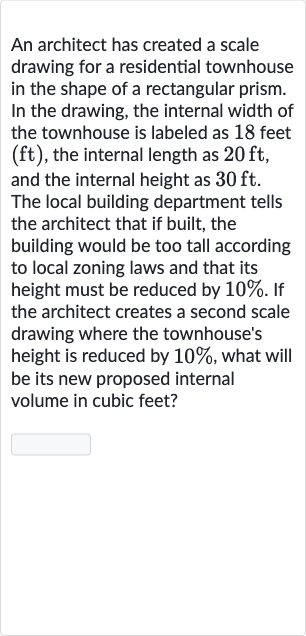AI tutor
Welcome to Bytelearn!
Let’s check out your problem:

An architect has created a scale drawing for a residential townhouse in the shape of a rectangular prism. In the drawing, the internal width of the townhouse is labeled as feet , the internal length as , and the internal height as . The local building department tells the architect that if built, the building would be too tall according to local zoning laws and that its height must be reduced by . If the architect creates a second scale drawing where the townhouse's height is reduced by , what will be its new proposed internal volume in cubic feet?
Full solution
Q. An architect has created a scale drawing for a residential townhouse in the shape of a rectangular prism. In the drawing, the internal width of the townhouse is labeled as feet , the internal length as , and the internal height as . The local building department tells the architect that if built, the building would be too tall according to local zoning laws and that its height must be reduced by . If the architect creates a second scale drawing where the townhouse's height is reduced by , what will be its new proposed internal volume in cubic feet?
- Calculate original volume: Calculate the original volume of the townhouse.The formula for the volume of a rectangular prism is .Original volume = (length) (width) (height).
- Perform calculation for original volume: Perform the calculation for the original volume.Original volume =
- Calculate new height after reduction: Calculate the new height after reducing it by . of the original height is . New height = original height - reduction = .
- Calculate new volume with reduced height: Calculate the new volume with the reduced height.New volume = length width new height.New volume = ft ft ft.
- Perform calculation for new volume: Perform the calculation for the new volume.New volume =
